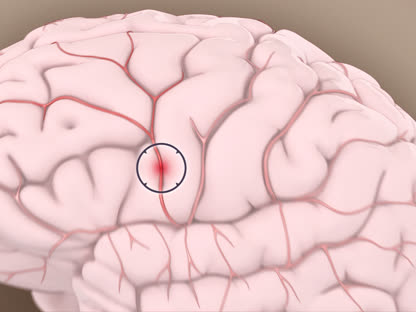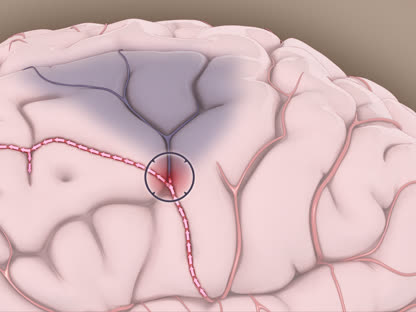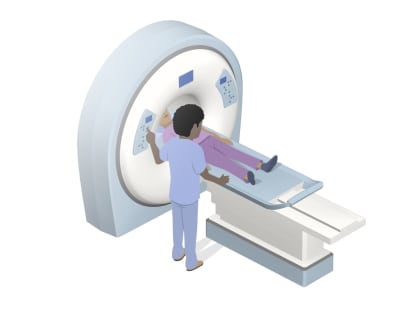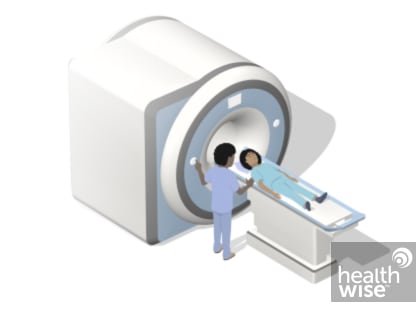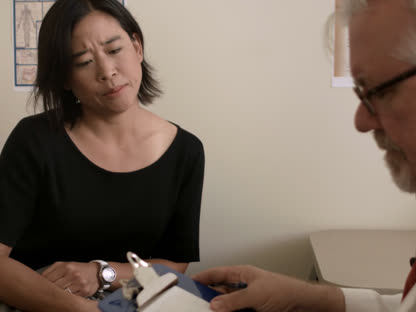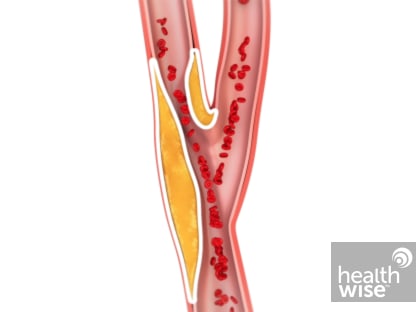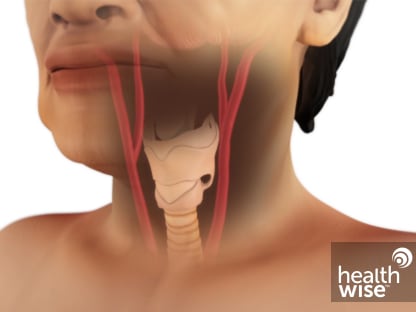Transient Ischemic Attack (TIA)
Condition Basics
What is a transient ischemic attack (TIA)?
A transient ischemic attack (TIA) is an event that happens when blood flow to part of the brain is blocked or reduced, Opens dialog, often by a blood clot. After a short time, blood flows again and symptoms go away. Symptoms are the same as a stroke, Opens dialog but don't last long and don't cause lasting damage.
What causes it?
A TIA occurs when the blood supply to part of the brain is blocked for a short time. This may be caused by a blood clot. A clot may form in damaged blood vessels. A blood clot can also travel to the brain from another location, like the heart.
What are the symptoms?
A TIA can cause many different symptoms. They include sudden numbness, tingling, weakness, and loss of movement in a part of your body. Other symptoms include sudden confusion, vision changes, trouble speaking, fainting, seizure, and trouble walking or balancing.
How is it diagnosed?
Your doctor asks you about your medical history and does a physical exam. You may have tests, like a CT scan, Opens dialog of the head or an MRI, Opens dialog. These tests check for damage to the brain and other diseases. Other tests are often done to find the cause of the TIA.
How is a TIA treated?
Treatment for TIA is focused on preventing a stroke. A heart-healthy lifestyle and medicine can help. You may take medicine to prevent blood clots, lower blood pressure, lower cholesterol, and manage other health problems. Some people have surgery or a procedure to widen narrowed carotid arteries that supply blood to the brain.
Related Videos
Health Tools help you make wise health decisions or take action to improve your health.
A TIA occurs when the blood supply to part of the brain is reduced or blocked for a short time. This may be caused by a blood clot in a blood vessel. A clot may form in blood vessels that have a buildup of a substance called plaque. This buildup is called hardening of the arteries or atherosclerosis. A blood clot can also travel to the brain from another location, such as the heart or blood vessels in the neck.
Brain cells are affected within seconds of the blockage. This causes symptoms in the parts of the body that are controlled by those cells.
Sometimes a TIA is caused by a sharp drop in blood pressure that reduces blood flow to the brain. This is called a "low-flow" TIA. It is not as common as other types.
A risk factor is anything that makes you more likely to have a particular health problem. Some of the risk factors for a TIA are things you can manage or change. These include:
- Having a health problem such as atrial fibrillation, diabetes, high blood pressure, and high cholesterol.
- Smoking.
- Drinking more than 2 alcoholic drinks a day for men and 1 drink a day for women.
- Being overweight.
- Not eating healthy foods.
- Physical inactivity.
Risk factors you can't change include:
- Having had a previous TIA or stroke.
- Having a family history of TIA or stroke. Your risk is greater if a parent, brother, or sister has had a stroke or TIA.
- Being older. The risk of TIA increases with age.
- Being African American, Alaskan Native, Native American, or South Asian American.
- Being female.
- Having certain problems during pregnancy, such as preeclampsia.
- Having gone through menopause.
Here are some ways to reduce your risk of having another TIA and a stroke.
- Work with your doctor to manage other health problems, including atrial fibrillation, diabetes, high blood pressure, and high cholesterol.
- Take your medicine exactly as prescribed.
- Have a heart-healthy lifestyle.
- Do not smoke or allow others to smoke around you. If you need help quitting, talk to your doctor.
- Limit alcohol to 2 drinks a day for men and 1 drink a day for women.
- Stay at a healthy weight. Lose weight if you need to.
- Be active. Ask your doctor what type and level of activity are safe for you.
- Eat heart-healthy foods. These include vegetables, fruits, nuts, beans, lean meat, fish, and whole grains. Limit sodium and sugar.
- If you think you may have a problem with alcohol or drug use, talk to your doctor.
- Get vaccinated against COVID-19, the flu, and pneumonia.
Learn more
Watch
Symptoms of a TIA are the same as symptoms of a stroke. But symptoms of a TIA don't last very long. They may go away in a few minutes.
If you have any of these symptoms, call 911 or other emergency services right away.
Symptoms include:
- Sudden numbness, tingling, weakness, or loss of movement in your face, arm, or leg, especially on only one side of your body.
- Sudden vision changes.
- Sudden trouble speaking.
- Sudden confusion or trouble understanding simple statements.
- Sudden problems with walking or balance.
Ask your family, friends, and coworkers to learn the signs of a TIA and stroke. They may notice these signs before you do. Make sure they know to call 911 if these signs appear.
A TIA doesn't cause lasting problems. But it is a serious warning sign of a possible stroke in the future. You can do a lot to lower your chance of having a stroke.
You and your doctor can work together to decide how to lower your risk of stroke. Medicines and a heart-healthy lifestyle can help.
Watch
Call 911 or other emergency services immediately if you have signs of a stroke, such as:
- Sudden numbness, tingling, weakness, or loss of movement in your face, arm, or leg, especially on only one side of your body
- Sudden vision changes
- Sudden trouble speaking
- Sudden confusion or trouble understanding simple statements
- Sudden problems with walking or balance
Call your doctor now if you have:
- Any signs of bleeding and you are taking aspirin or other medicines that prevent blood clotting.
Call your doctor today if you think you have had a TIA in the past and have not yet talked with your doctor about your symptoms.
You need to be checked by a doctor right away if you have had or are having a TIA. Your doctor will ask you about your medical history and do a physical exam. The exam results may be normal if the symptoms have already gone away.
If a TIA is suspected, the doctor may want to do tests. The tests include a CT scan, Opens dialog of the head or an MRI, Opens dialog to check for brain damage and look for diseases.
More tests are often done to find the cause of the TIA. Tests may include:
- An electrocardiogram (ECG, EKG) to check for heart rhythm problems that can lead to blood clots.
- An echocardiogram (echo) to look for clots or heart problems.
- Tests that check for narrowing or blockage in blood vessels of the neck, such as an ultrasound, Opens dialog.
- Certain blood tests.
Learn more
Watch
If you've had a TIA, you need to see a doctor right away. After a TIA, you are at risk for a stroke. So you may stay in the hospital. You may have more tests and treatment.
Treatment for TIA is focused on preventing a stroke. A heart-healthy lifestyle and medicine can help. This lifestyle includes eating healthy, being active, staying at a healthy weight, and not smoking. You may take medicine to prevent blood clots, lower blood pressure, lower cholesterol, and manage other health problems. Some people have surgery or a procedure to widen narrowed carotid arteries that supply blood to the brain.
Medicines
- Be safe with medicines. Take your medicines exactly as prescribed. Call your doctor if you think you are having a problem with your medicine.
- If you take a blood thinner, such as aspirin, be sure you get instructions about how to take your medicine safely. Blood thinners can cause serious bleeding problems.
- Call your doctor if you are not able to take your medicines for any reason.
- Do not take any over-the-counter medicines or herbal products without talking to your doctor first.
- If you use hormonal birth control or hormone therapy for menopause, talk to your doctor. Ask if these are right for you. They may raise the risk of stroke in some people.
Heart-healthy lifestyle
- Do not smoke. If you need help quitting, talk to your doctor about stop-smoking programs and medicines.
- Be active. If your doctor recommends it, get more exercise. Walking is a good choice. Bit by bit, increase the amount you walk every day. Try for at least 30 minutes on most days of the week. You also may want to swim, bike, or do other activities.
- Eat heart-healthy foods. These include vegetables, fruits, nuts, beans, lean meat, fish, and whole grains. Limit sodium and sugar.
- Stay at a healthy weight. Lose weight if you need to.
- Limit alcohol to 2 drinks a day for men and 1 drink a day for women.
Staying healthy
- Manage other health problems that raise your risk of stroke. These include atrial fibrillation, diabetes, high blood pressure, and high cholesterol.
- If you think you may have a problem with alcohol or drug use, talk to your doctor.
- Avoid infections such as COVID-19, colds, and the flu. Get the flu vaccine every year. Get a pneumococcal vaccine shot. If you have had one before, ask your doctor whether you need another dose. Stay up to date on your COVID-19 vaccines.
Learn more
Watch
Your doctor will probably prescribe several medicines after you've had a TIA. The medicines can help lower your risk of another TIA and a stroke.
Medicines to prevent blood clots are often used. This is because blood clots can cause TIAs and strokes. The types of medicines that prevent clotting are antiplatelets and anticoagulants.
Medicines to lower cholesterol and blood pressure are also used to prevent TIAs and strokes.
Medicines that prevent blood clots
Antiplatelet medicines keep platelets, Opens dialog in the blood from sticking together. They include:
- Aspirin.
- Aspirin combined with dipyridamole.
- Other antiplatelet medicines, such as clopidogrel.
Anticoagulants, Opens dialog prevent blood clots from forming. And they keep existing blood clots from getting bigger. Examples include:
- Direct oral anticoagulants.
- Warfarin.
You may take this type of medicine if you have atrial fibrillation or another condition that makes you more likely to have a stroke.
Cholesterol medicines
Cholesterol medicines lower cholesterol and the risk for a TIA or stroke. Examples are:
- Statins.
- Cholesterol absorption inhibitors.
- PCSK9-inhibitors.
Blood pressure medicines
Blood pressure medicines lower blood pressure and the risk for a TIA or stroke. Blood pressure medicines include:
- Angiotensin II receptor blockers (ARBs).
- Angiotensin-converting enzyme (ACE) inhibitors.
- Diuretics.
Learn more
If you have serious blockage in the carotid arteries, Opens dialog in your neck, you may choose to have a procedure to open the narrowed arteries. This can improve blood flow and help prevent a stroke.
During a surgical procedure, called carotid endarterectomy, a surgeon removes plaque, Opens dialog buildup in the carotid arteries. During a catheter procedure, called carotid artery stenting, a thin tube is used to widen the narrowed artery and place a stent, Opens dialog inside. The stent helps keep the artery open.
When a procedure is being considered after a TIA, the benefits and risks must be carefully weighed because the procedures may cause a stroke. Factors in the decision about having a procedure include your age, prior overall health, and current condition.
Learn more
Watch
Current as of: July 31, 2024
Author: Ignite Healthwise, LLC Staff
Clinical Review Board
All Healthwise education is reviewed by a team that includes physicians, nurses, advanced practitioners, registered dieticians, and other healthcare professionals.
Current as of: July 31, 2024
Author: Ignite Healthwise, LLC Staff
Clinical Review Board
All Healthwise education is reviewed by a team that includes physicians, nurses, advanced practitioners, registered dieticians, and other healthcare professionals.
Topic Contents
This information does not replace the advice of a doctor. Ignite Healthwise, LLC, disclaims any warranty or liability for your use of this information. Your use of this information means that you agree to the Terms of Use. Learn how we develop our content.









